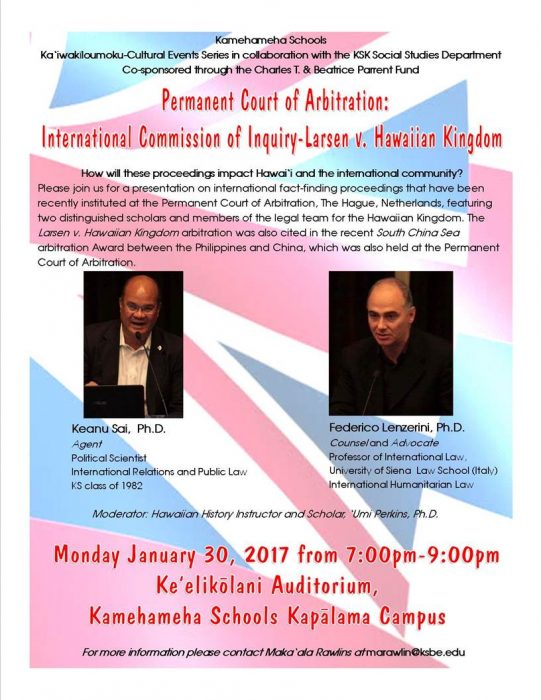
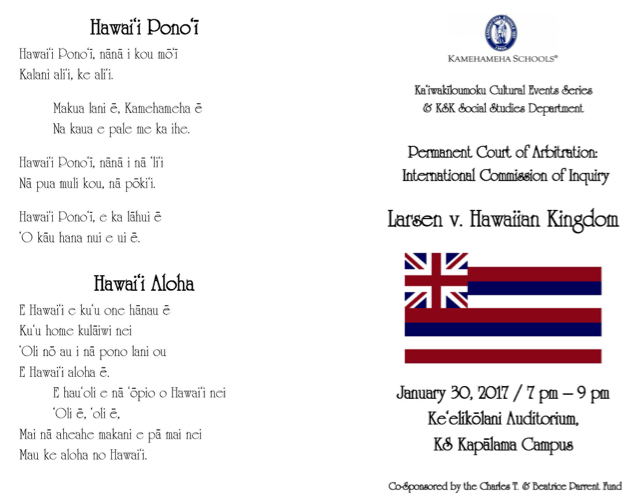
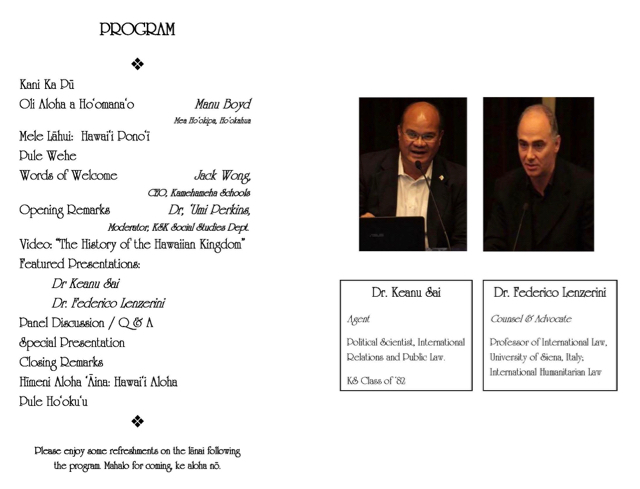
International Proceedings Presented at the Kamehameha Schools Jan. 30
11








Pūnana Leo o Kona presents the 4th annual ʻAha Aloha ʻŌlelo on January 14, 2017 from 9:00am to 4:00pm at Makaʻeo (Old Airport Pavilion). ʻAha Aloha ʻŌlelo is an event for the entire ʻohana featuring live entertainment by Danny Carvalho, Kalani Peʻa, Duncan Kamakana Osorio, Jon Osorio and Jamaica Osorio. The event will also feature vendors, Hawaiian food and a Keikiland with bouncers, games and a petting zoo. A Hawaiian language competition with well over 100 competitors from schools such as Pūnana Leo o Kona, ʻEhunuikaimalino, Nāwahīokalaniʻōpuʻu and Pūnana Leo o Waiʻanae from Waiʻanae, Oʻahu will also be held. Tickets to the event are $10 or $12 at the door and keiki 10 and under are free.
The theme of this yearʻs Hawaiian language competition is built around a speech given on September 6, 1896 at a Hālāwai Makaʻāinana at Palace Square in Honolulu by James Keauiluna Kaulia, calling on the people of Hawaiʻi to “kūʻē loa aku i ka hoʻohui ʻia o Hawaiʻi me ʻAmelika a hiki i ke aloha ʻāina hope loa!” Kaulia was the President of the Hui Aloha ʻĀina, or Hawaiian Patriotic League when the question of annexing Hawaiʻi to the United States was before the U.S. government. Kaulia and others, including David Kalauokalani, Emma Nāwahī and Kuaihelani Campbell, led a petition drive protesting the annexation of Hawaiʻi to the United States of America. They sent out delegates to each island and all of its communities and through their collective efforts, over 37,000 signatures were gathered during a time in Hawaiian history where there were only about 40,000 Native Hawaiians alive.
After the gathering of the signatures, Kaulia and Kalauokalani, along with John Richardson and William Auld, traveled to Washington D.C. to deliver the anti-annexation petitions. Upon arriving to D.C., it was known that there were already 58 votes in U.S Congress for annexation, with only two more votes being needed to ratify the treaty presented to congress by the unlawful Republic of Hawaiʻi under Sanford Dole. The Commission was able to meet with many different Senators and Congressmen and they were able to have the annexation petitions read to the Senate and formally accepted. By the time the Commission left Washington D.C. to return back to Hawaiʻi, there were only 46 votes in the Senate for annexation, far below the 60 votes required to ratify the treaty. The treaty of annexation was dead. Hawaiʻi remained an independent country, as it has been since November 28, 1843, albeit under an illegal, unlawful and self-proclaimed government.
“These petitions show us the potential of our Lāhui. Our kūpuna were actively engaged in the political issues surrounding them and their country. We are in a point of history where we face very similar issues,” said Kahoʻokahi Kanuha, the organizer of the Hawaiian language competition. “I am hopeful that this competition and event will remind us of the inherited kuleana we have to this ʻāina. These petitions show us who we were, who we are and most importantly who we still must be.”
###
For more information, e ʻoluʻolu, contact:
Kahoʻokahi Kanuha
808-936-4249
kahookahi@ahapunanaleo.org
Facebook: ʻAha Aloha ʻŌlelo
Instagram: @alohaolelo
Twitter: @alohaolelo
In 2016, Duke University Press published Tom Coffman’s Nation Within: The History of the American Occupation of Hawai‘i. While this book has been in circulation since 1998, it is the first time that an academic publisher has put its name to the book. The goal of Duke University Press is “to contribute boldly to the international community of scholarship.” “By insisting on thorough peer review procedures in combination with careful editorial judgment, the Press performs an intellectual gatekeeping function, ensuring that only scholarship of the highest quality receives the imprimatur of the University.”
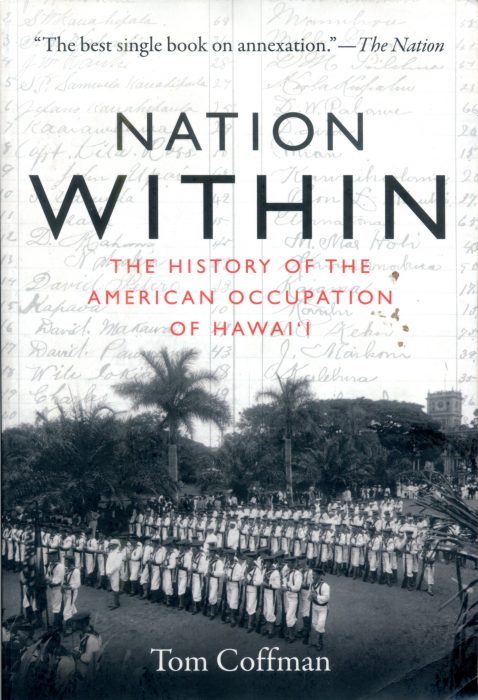
Dr. Keanu Sai, a political scientist, whose doctoral research covered the American occupation of the Hawaiian Kingdom and its continued existence today as an independent State, was asked by the Hawaiian Journal of History to write a book review of Coffman’s Nation Within for its first publication in 2017. In his review, Dr. Sai reveals the “smoking gun” that was brought to his attention by Dr. Ron Williams of the University of Hawai‘i at Manoa.
***************************************************************
In Nation Within: The History of the American Occupation of Hawai‘i, Tom Coffman exhibits a radical shift by historians in interpreting political events post-1893. When Coffman first published his book in 1998, his title reflected a common misunderstanding of annexation. But in 2009, he revised the title by replacing the word Annexation with the word Occupation. Coffman admitted he made this change because of international law (p. xvi). By shifting the interpretive lens to international law, Coffman not only changed the view to occupation, but would also change the view of the government’s overthrow in 1893. While the book lacks any explanation of applicable international laws, he does an excellent job of providing an easy reading of facts for international law to interpret.
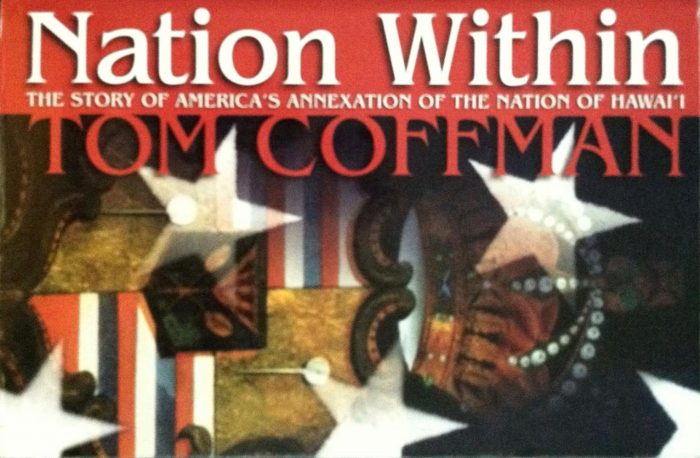
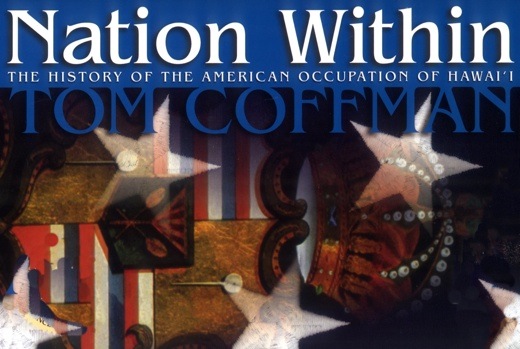
In international law, there is a fundamental rule that diplomats have a duty to not intervene in the internal affairs of the sovereign State they are accredited to. Every sovereign State has a right “to establish, alter, or abolish, its own municipal constitution [and] no foreign State can interfere with the exercise of this right” (Halleck’s International Law, 3rd ed., p. 94). For an ambassador, a violation of this rule would have grave consequences. An offended State could proceed “against an ambassador as a public enemy…if justice should be refused by his own sovereign” (Wheaton’s International Law, 8th ed., p. 301).
John Stevens, the American ambassador to the Hawaiian Kingdom arrived in the islands in the summer of 1889. As Coffman notes, Stevens was already fixated with annexation when he “wrote that the ‘golden hour’ for resolving the future status of Hawai‘i was at hand,” (p. 114) and began to collude with Lorrin Thurston (p. 116). Thurston was not an American citizen but rather a third-generation Hawaiian subject. Stevens’ opportunity to intervene and seek annexation would occur after Lili‘uokalani “attempted to promulgate a new constitution, [which] was the event Thurston and Stevens had been waiting for” (p. 120).
On January 16, Stevens orders the landing of U.S. troops and “tells Thurston that if the annexationists control three buildings—‘Iolani Palace, Ali‘iolani Hale, and the Archives—he will announce American recognition of the new government” (p. 121). The following day, “Stevens tells the queen’s cabinet that he will protect the annexationists if they are attacked or arrested by government police” (Ibid.). However, unbeknownst to Stevens, the insurgents only took over Ali‘iolani Hale, which housed “clerks of the Kingdom” (p. 125). One of the insurgents, Samuel Damon, knowing Stevens’ recognition was premature, sought to convince Lili‘uokalani that her resistance was futile because the United States had already recognized the new government, and that she should order Marshal Charles Wilson, head of the government police, to give up the police station. Wilson was planning an assault on the government building to apprehend the insurgents for treason in spite of the presence of U.S. troops.
International law clearly interprets these events as intervention and Stevens to be a “public enemy” of the Hawaiian Kingdom. This was the same conclusion reached by President Grover Cleveland, whose investigation was an indictment of Stevens and the commander of the USS Boston, Captain Gilbert Wiltse. “The lawful Government of Hawai‘i was overthrown without the drawing of a sword or the firing of a shot,” Cleveland said, “by a process every step of which, it may be safely asserted, is directly traceable to and dependent for its success upon the agency of the United States acting through its diplomatic and naval representatives” (p. 144). Because of diplomatic immunity, the United States, as the sending State, would be obliged to prosecute Stevens and Wiltse for treason under American law.
On December 20, 1893, a resolution of the U.S. Senate called for a separate investigation to be conducted by the Senate Committee on Foreign Relations. Chaired by Senator John Morgan, a vocal annexationist, the purpose of the Senate investigation was to repudiate Cleveland’s investigation and to vindicate Stevens and Wiltse of criminal liability. One week later, the Committee held its first day of hearings in Washington, DC. Stevens appeared before the Committee and fielded questions under oath on January 20, 1894. When asked by the Chairman if his recognition of the provisional government was for the “purpose of dethroning the Queen,” he responded, “Not the slightest—absolute noninterference was my purpose” (Report from the Committee on Foreign Relations— Appendix, p. 550).
After the hearings, two reports were submitted on February 26, 1894—a Committee Report and a Minority Report. The committee of eight senators was split down the middle, with Morgan giving the majority vote for the Committee Report. Half of the committee members did not believe Stevens’ testimony of his non-intervention. The Minority Report stated, “We can not concur…in so much of the foregoing report as exonerates the minister of the United States, Mr. Stevens, from active officious and unbecoming participation in the events which led to the revolution” (Ibid., p. xxxv).
The Senate Committee’s investigation could find no direct evidence that would disprove Stevens’ sworn testimony, but in 2016, the “smoking gun” was found that would prove Stevens was a public enemy of the Hawaiian Kingdom, committed perjury before the Committee, and would no doubt have been prosecuted under the 1790 federal statute of treason. The Hawaiian Mission Houses Archives is processing a collection of documents given to them by a descendent of William O. Smith. Smith was an insurgent that served as the attorney general for Sanford Dole, so-called president of the provisional government.
The “smoking gun” is a note to Dole signed by Stevens marked “private” and written under the letterhead of the “United States Legation” in Honolulu and dated January 17, 1893. Stevens writes, “Judge Dole: I would advise not to make known of my recognition of the de facto Provisional Government until said Government is in possession of the police station.”
As a political scientist, Coffman’s book is a welcomed addition to arresting revisionist history.
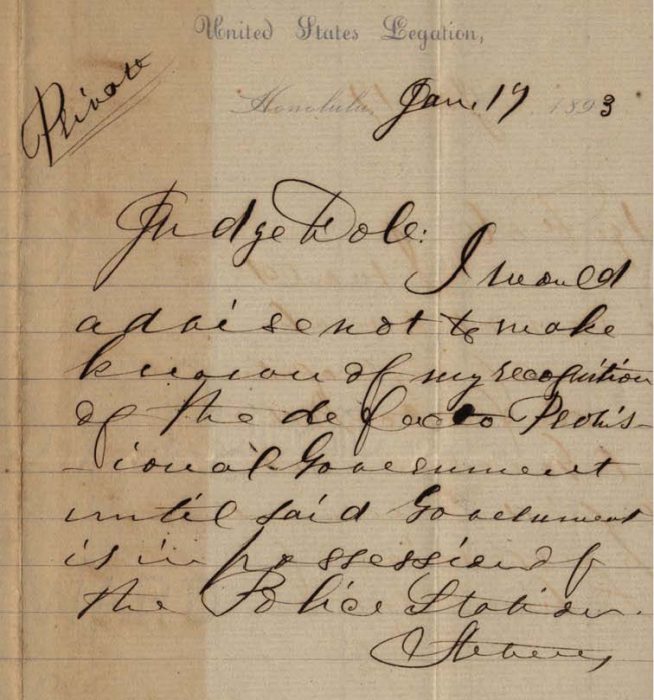
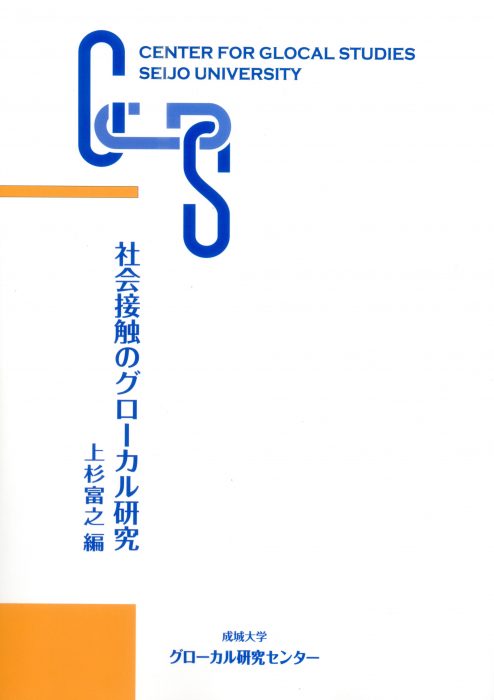
Japan’s Seijo University’s Center for Glocal Studies has published, in its latest journal for 2016, an article authored by Dennis Riches titled “This is not America: The Acting Government of the Hawaiian Kingdom Goes Global with Legal Challenges to End Occupation [this is a hot link to download the article].” The word Glocal Studies is a combination of the words Global and Local Studies.
The study focused on the American occupation of Hawai‘i and its global impact, which includes war crimes. It also included an interview of Dr. Keanu Sai by the author who is a faculty member of Seijo University, Japan. Seijo’s Glocal Research Center is also supported by the Japanese Ministry of Education, Culture, Sports, Science and Technology.
In his concluding remarks of the study, the author wrote:
I became interested in Hawai‘i’s status as an occupied country through an earlier interest in the struggle of Okinawans to have US military bases removed from their territory. I naively thought, like many in Japan, that the US should move these military operations back to Hawai‘i because they rightly belong on American territory. Yet as I compared the two places, I learned that under international law Hawai‘i actually had a stronger claim than Okinawa on the right to reject an American military presence. Unfortunately, Okinawa never had foreign treaties and recognition as an independent state before it was absorbed by Japan. This leaves Okinawa to fight for self-determination through a political negotiation with the Japanese government, and the Japanese government is very committed to its alliance with America. Although Prime Minister Shinzo Abe stated in his speech of August 15, 2015, “We shall abandon colonial rule forever and respect the right of self-determination of all peoples throughout the world,” it is unlikely that he had Okinawans in mind, or anyone specifically, as a people he would assist in becoming independent.
During the interview, as a spokesperson for the provisional government, Professor Sai was careful not to discuss the policy or ideology that a future legitimate government would follow. Those are to be decided by democratic choices that Hawaiians make after the occupation ends. However, it was encouraging to hear Professor Sai, a former US Army captain, express a strong personal view that Hawai‘i’s record as a neutral country is not something that should be up for future debate. It’s a fundamental value that makes the work to restore the nation worthwhile, and it is something that can inspire the global community as well.
There is an increasing global desire for America to scale back its interventionism and close its global network of military bases. The day has come when the world doesn’t want it, and America can no longer afford it. It is ironic that a place that everyone thinks is American is the place that has the strongest chance of using international law to expel the American military presence. Other nations are bound by their treaties and Status of Forces Agreements. It is also inspiring too to think that this will happen in the place that was the last place on the globe to be inhabited by humans, and the last to be contacted by the European explorers who launched the age of Western Empire.
Today, Western science turns its back on earthly problems as it tries to build telescopes and train astronauts to Mars-walk on Hawaiian mountains, but for those who prefer to deal with the home we have, Hawai‘i can be a symbol of our last hope to avoid the catastrophes of environmental destruction and war, just as it was a last hope for the Polynesian explorers who first came in the years of the early Christian calendar—an interesting coincidence considering the peaceful aspirations of Christianity that preceded the meeting of two cultures in Hawai‘i in the 18th century. Now that Japan has reinterpreted its “peace” constitution to allow for overseas deployments in assistance of allies, the world should support Hawai‘i not only for the sake of self-interested realism but more importantly for the role Hawai‘i can play as a new standard bearer of the idea that nations can renounce war, choose neutrality and gain security from a system of international law that protects their sovereignty.
November 28th is the most important national holiday in the Hawaiian Kingdom. It is the day Great Britain and France formally recognized the Hawaiian Islands as an “independent state” in 1843, and has since been celebrated as “Independence Day,” which in the Hawaiian language is “La Ku‘oko‘a.” Here follows the story of this momentous event from the Hawaiian Kingdom Board of Education history textbook titled “A Brief History of the Hawaiian People” published in 1891.
**************************************
The First Embassy to Foreign Powers—In February, 1842, Sir George Simpson and Dr. McLaughlin, governors in the service of the Hudson Bay Company, arrived at Honolulu 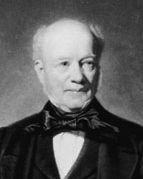 on business, and became interested in the native people and their government. After a candid examination of the controversies existing between their own countrymen and the Hawaiian Government, they became convinced that the latter had been unjustly accused. Sir George offered to loan the government ten thousand pounds in cash, and advised the king to send commissioners to the United States and Europe with full power to negotiate new treaties, and to obtain a
on business, and became interested in the native people and their government. After a candid examination of the controversies existing between their own countrymen and the Hawaiian Government, they became convinced that the latter had been unjustly accused. Sir George offered to loan the government ten thousand pounds in cash, and advised the king to send commissioners to the United States and Europe with full power to negotiate new treaties, and to obtain a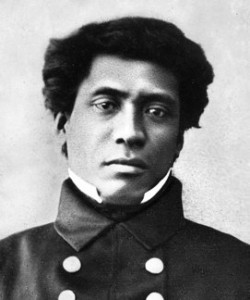 guarantee of the independence of the kingdom.
guarantee of the independence of the kingdom.
Accordingly Sir George Simpson, Haalilio, the king’s secretary, and Mr. Richards were appointed joint ministers-plenipotentiary to the three powers on the 8th of April, 1842.
 Mr. Richards also received full power of attorney for the king. Sir George left for Alaska, whence he traveled through Siberia, arriving in England in November. Messrs. Richards and Haalilio sailed July 8th, 1842, in a chartered schooner for Mazatlan, on their way to the United States*
Mr. Richards also received full power of attorney for the king. Sir George left for Alaska, whence he traveled through Siberia, arriving in England in November. Messrs. Richards and Haalilio sailed July 8th, 1842, in a chartered schooner for Mazatlan, on their way to the United States*
*Their business was kept a profound secret at the time.
Proceedings of the British Consul—As soon as these facts became known, Mr. Charlton followed the embassy in order to defeat its object. He left suddenly on September 26th, 1842, for London via Mexico, sending back a threatening letter to the king, in which he informed him that he had appointed Mr. Alexander Simpson as acting-consul of Great Britain. As this individual, who was a relative of Sir George, was an avowed advocate of the annexation of the islands to Great Britain, and had insulted and threatened the governor of Oahu, the king declined to recognize him as British consul. Meanwhile Mr. Charlton laid his grievances before Lord George Paulet commanding the British frigate “Carysfort,” at Mazatlan, Mexico. Mr. Simpson also sent dispatches to the coast in November, representing that the property and persons of his countrymen were in danger, which introduced Rear-Admiral Thomas to order the “Carysfort” to Honolulu to inquire into the matter.
Recognition by the United States—Messres. Richards and Haalilio arrived in Washington early in December, and had several interviews with Daniel Webster, the Secretary of State, from whom they received an official letter December 19th, 1842, which recognized the independence of the Hawaiian Kingdom, and declared, “as the sense of the government of the United States, that the government of the Sandwich Islands ought to be respected; that no power ought to take possession of the islands, either as a conquest or for the purpose of the colonization; and that no power ought to seek for any undue control over the existing government, or any exclusive privileges or preferences in matters of commerce.” *
Secretary of State, from whom they received an official letter December 19th, 1842, which recognized the independence of the Hawaiian Kingdom, and declared, “as the sense of the government of the United States, that the government of the Sandwich Islands ought to be respected; that no power ought to take possession of the islands, either as a conquest or for the purpose of the colonization; and that no power ought to seek for any undue control over the existing government, or any exclusive privileges or preferences in matters of commerce.” *
*The same sentiments were expressed in President Tyler’s message to Congress of December 30th, and in the Report of the Committee on Foreign Relations, written by John Quincy Adams.
Success of the Embassy in Europe—The king’s envoys proceeded to London, where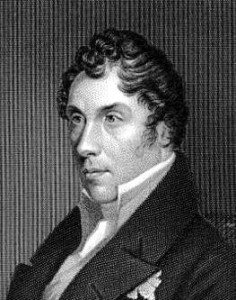 they had been preceded by the Sir George Simpson, and had an interview with the Earl of Aberdeen, Secretary of State for Foreign Affairs, on the 22d of February, 1843.
they had been preceded by the Sir George Simpson, and had an interview with the Earl of Aberdeen, Secretary of State for Foreign Affairs, on the 22d of February, 1843.
Lord Aberdeen at first declined to receive them as ministers from an independent state, or to negotiate a treaty, alleging that the king did not govern, but that he was “exclusively under the influence of Americans to the detriment of British interests,” and would not admit that the government of the United States had yet fully recognized the independence of the islands.
Sir George and Mr. Richards did not, however, lose heart, but went on to Brussels March 8th, by a previous arrangement made with Mr. Brinsmade. While there, they had an interview with Leopold I., king of the Belgians, who received them with great courtesy, and promised to use his influence to obtain the recognition of Hawaiian independence. This influence was great, both from his eminent personal qualities and from his close relationship to the royal families of England and France.
Encouraged by this pledge, the envoys proceeded to Paris, where, on the 17th, M. Guizot, the Minister of Foreign Affairs, received them in the kindest manner, and at once engaged, in behalf of France, to recognize the independence of the islands. He made the same statement to Lord Cowley, the British ambassador, on the 19th, and thus cleared the way for the embassy in England.
They immediately returned to London, where Sir George had a long interview with Lord Aberdeen on the 25th, in which he explained the actual state of affairs at the islands, and received an assurance that Mr. Charlton would be removed. On the 1st of April, 1843, the Earl of Aberdeen formally replied to the king’s commissioners, declaring that “Her Majesty’s Government are willing and have determined to recognize the independence of the Sandwich Islands under their present sovereign,” but insisting on the perfect equality of all foreigners in the islands before the law, and adding that grave complaints had been received from British subjects of undue rigor exercised toward them, and improper partiality toward others in the administration of justice. Sir George Simpson left for Canada April 3d, 1843.
Recognition of the Independence of the Islands—Lord Aberdeen, on the 13th of June, assured the Hawaiian envoys that “Her Majesty’s government had no intention to retain possession of the Sandwich Islands,” and a similar declaration was made to the governments of France and the United States.
At length, on the 28th of November, 1843, the two governments of France and England united in a joint declaration to the effect that “Her Majesty, the queen of the United Kingdom of Great Britain and Ireland, and His Majesty, the king of the French, taking into consideration the existence in the Sandwich Islands of a government capable of providing for the regularity of its relations with foreign nations have thought it right to engage reciprocally to consider the Sandwich Islands as an independent state, and never to take possession, either directly or under the title of a protectorate, or under any other form, of any part of the territory of which they are composed…”
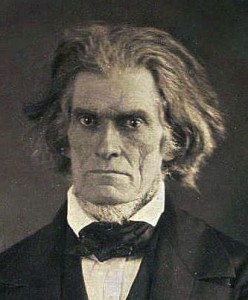 This was the final act by which the Hawaiian Kingdom was admitted within the pale of civilized nations. Finding that nothing more could be accomplished for the present in Paris, Messrs. Richards and Haalilio returned to the United States in the spring of 1844. On the 6th of July they received a dispatch from Mr. J.C. Calhoun, the Secretary of State, informing them that the President regarded the statement of Mr. Webster and the appointment of a commissioner “as a full recognition on the part of the United States of the independence of the Hawaiian Government.”
This was the final act by which the Hawaiian Kingdom was admitted within the pale of civilized nations. Finding that nothing more could be accomplished for the present in Paris, Messrs. Richards and Haalilio returned to the United States in the spring of 1844. On the 6th of July they received a dispatch from Mr. J.C. Calhoun, the Secretary of State, informing them that the President regarded the statement of Mr. Webster and the appointment of a commissioner “as a full recognition on the part of the United States of the independence of the Hawaiian Government.”
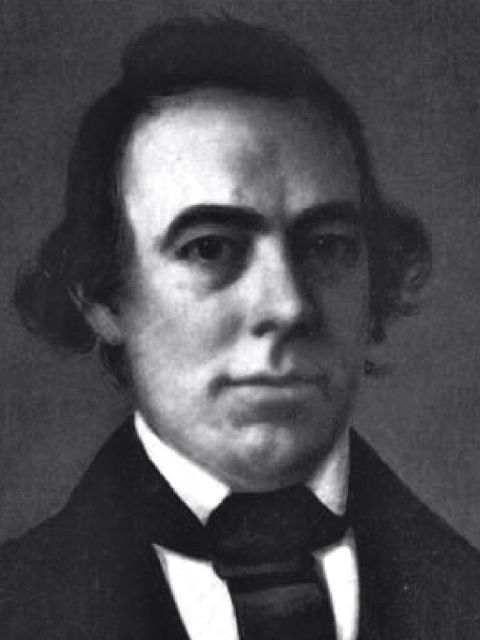 Below is a reprint of an article published in the Polynesian newspaper in 1845. The author is William Richards being one of the commissioners along with Timoteo Ha‘alilio and Sir George Simpson who were commissioned by King Kamehameha III with the purpose of securing the recognition of the Hawaiian Kingdom as an independent State from Great Britain, France and the United States. Of the three, Ha‘alilio did not survive. He passed away on the ship The Montreal on his way home after departing Hawai‘i in 1842.
Below is a reprint of an article published in the Polynesian newspaper in 1845. The author is William Richards being one of the commissioners along with Timoteo Ha‘alilio and Sir George Simpson who were commissioned by King Kamehameha III with the purpose of securing the recognition of the Hawaiian Kingdom as an independent State from Great Britain, France and the United States. Of the three, Ha‘alilio did not survive. He passed away on the ship The Montreal on his way home after departing Hawai‘i in 1842.
THE POLYNESIAN.
OFFICIAL JOURNAL OF THE HAWAIIAN GOVERNMENT.
HONOLULU, SATURDAY, MARCH 29, 1845.
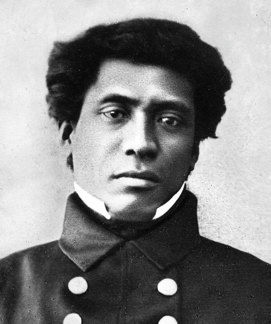 The Montreal, from Boston, arrived off our harbor on Sunday last, at day break. Her ensign was noticed to be half-mast, and various conjectures began to circulate through the town, when William Richards, Esq., H.H.M.’s Commissioner to the U. States and Europe, whose arrival has been so long and anxiously awaited, landed and proceeded directly to the palace, where he immediately made known to their Majesties the melancholy news of the death of his fellow Commissioner, Mr. T. Haalilio, who died at sea on the 3d Dec. ult. The sad intelligence soon spread over the place; the flags of the men of war, merchant vessels, the consulates, batteries and other places, were immediately lowered to half-mast as a general expression of sympathy at the nation’s loss. Great hopes had been entertained both among Hawaiians and foreigners, of the good results that would ensue to the kingdom from the addition to its councils of one of so intelligent a mind, stored as it was with the fruits of observant travel, and the advantages derived from long and familiar intercourse in the best circles of Europe and the United States. A numerous band of personal friends to whom he had been endeared from his earliest intercourse by his sincerity of manners and peculiarly affectionate deportment, were earnestly looking to welcome him home. But above all, their Majesties, his intimate friends, the Governors, the other high chiefs and his widowed mother were awaiting his arrival with an earnestness of hope that the deepest affections of the heart can alone produce. The last tidings from him had been those of health. He was then soon to embark, and his speedy arrival to the shores and friends he loved so well, was anticipated without a doubt. So unexpected a termination of his existence, after having escaped the dangers of long and trying journe[y]s and voyagings, while as it were, on the very eve of again treading his native land, brings with it more than common anguish. It is not for us to life the veil and expose the scene which ensued at the palace upon the communication of the tidings. The whole court were there assembled. Those who had been suddenly deprived of their choicest hope when on the eve of its full indulgence, can alone estimate the bereavement.
The Montreal, from Boston, arrived off our harbor on Sunday last, at day break. Her ensign was noticed to be half-mast, and various conjectures began to circulate through the town, when William Richards, Esq., H.H.M.’s Commissioner to the U. States and Europe, whose arrival has been so long and anxiously awaited, landed and proceeded directly to the palace, where he immediately made known to their Majesties the melancholy news of the death of his fellow Commissioner, Mr. T. Haalilio, who died at sea on the 3d Dec. ult. The sad intelligence soon spread over the place; the flags of the men of war, merchant vessels, the consulates, batteries and other places, were immediately lowered to half-mast as a general expression of sympathy at the nation’s loss. Great hopes had been entertained both among Hawaiians and foreigners, of the good results that would ensue to the kingdom from the addition to its councils of one of so intelligent a mind, stored as it was with the fruits of observant travel, and the advantages derived from long and familiar intercourse in the best circles of Europe and the United States. A numerous band of personal friends to whom he had been endeared from his earliest intercourse by his sincerity of manners and peculiarly affectionate deportment, were earnestly looking to welcome him home. But above all, their Majesties, his intimate friends, the Governors, the other high chiefs and his widowed mother were awaiting his arrival with an earnestness of hope that the deepest affections of the heart can alone produce. The last tidings from him had been those of health. He was then soon to embark, and his speedy arrival to the shores and friends he loved so well, was anticipated without a doubt. So unexpected a termination of his existence, after having escaped the dangers of long and trying journe[y]s and voyagings, while as it were, on the very eve of again treading his native land, brings with it more than common anguish. It is not for us to life the veil and expose the scene which ensued at the palace upon the communication of the tidings. The whole court were there assembled. Those who had been suddenly deprived of their choicest hope when on the eve of its full indulgence, can alone estimate the bereavement.
It is satisfactory to know that every attention affection or sympathy could suggest, was afforded the deceased. Previous to our own departure from the United States, we were a witness to the deep interest and respect which Mr. Haalilio received in the refined society of Boston. But our already crowded columns will not allow us further to dilate. From Mr. Richards he received in all stages of his journey the most unremitting care, and towards the close of his life he was ever at his bed-side. Our readers will be able to glean from the brief memoir which follows this, prepared by Mr. R. some further insight into his life and untimely end. We say untimely, but man seeeth not as god seeeth.
Haalilio was born in 1808, at Koolau; Oahu. His parents were of respectable rank, and much esteemed. His father died while he was quite young, and his widowed mother subsequently married the Governor of Molokai, an island depend[e]nt on the Governor of Maui. After this death, she retained the authority of the island, and acted as Governess for the period of some fifteen years.
At the age of about eight years, Haalilio removed to Hilo on Hawaii, where he was adopted in the family, and became one of the playmates, of the young prince, now King of the Islands. He traveled round to different parts of the Islands with the prince, conforming to the various heathenish rites which were then in vogue. From that period he remained one of the most intimate companions and associates of the King.
At the age of about thirteen, he commenced learning to read, and was a pleasant pupil and made great proficiency. There were then no regularly established schools, and he was a private pupil of Mrs. Bingham. He learned to read English as well as Hawaiian, though at that period he did not understand what he read. He was taught arithmetic and penmanship by Mr. Bingham, and was early employed by the King to do his writing–not as an official secretary, but as an amanuensis or clerk. As be advanced in years he had various duties and employments assigned him, requiring skill and responsibility. Being associated with the King, he was always received into society with him, and thus enjoyed various advantages which he prized very much and improved in the best manner. He thus became acquainted with the usages of good society which he never failed to adopt as fast as he became acquainted with them.
To him also the King committed the charge of his private purse, which he held till the time of his embarkation. It thus became his duty to make most of the purchases required by the King, and he thereby had opportunity to become acquainted with the detail of mercantile business, of which he acquired a very commendable knowledge. His habits of business were many of them worthy of imitation even by the most enlightened. He was in a good degree systematic, and was extremely careful of every thing committed to this charge.
Besides acquaintance with mercantile transactions, he also acquired a very full knowledge of the political relations of the country. He was a strenuous advocate for a constitutional and representative government, and aided not a little in effecting those changes by which the rights of the lower classes have been secured. He was well acquainted with the practical influence of the former system of government, and considered a change necessary to the welfare of the nation.
The King and Chiefs could not fail to see the real value of such a man, and they therefore promoted him to offices to which his birth would not, according to the old system, have entitled him. He was properly the Lieutenant-Governor of the Island of Oahu, and regularly acted as Governor during the absence of the incumbent. It was expected also that he would succeed the present Governor in his office, had he outlived him. He was also elected a member of the council of Nobles, and materially aided that body in their deliberations. At the last meeting of the Legislature previous to his leaving the country, he was chosen President of the Treasury Board, and thus in a considerable degree he had control of the finances of the nation.
In the month of April, 1842, he was appointed a joint Commissioner with Mr. Richards, to the Courts of the U.S.A, England and France. He embarked on the 18th of July following on board the sch. Shaw, and arrived at Mazatlan Sept. 1st. While on the passage he often talked of home and friends with a tenderness and emotion that showed a high degree of sensibility and refinement. On his arrival at port, he was received with great hospitality. In crossing Mexico, he was deeply interested in noticing the peculiarities of the scenery, the character of the people, and the natural history of the country. Nothing escaped his observation; and the correctness and good sense of his remarks, rendered him not merely a pleasant but a profitable companion. After spending a fortnight at Vera Cruz, he was by the politeness of Capt. Newton received on board the U.S. steamer Missouri, about to sail to the mouth of the Mississippi. On board that vessel he had the company of Mr. Mayer, the U.S. Sec. of Legation at Mexico; and Mr. Southall, Bearer of Despatches, with whom he proceeded to New Orleans, and then by the mail route to Washington, where he arrived on the 3d of Dec. The results of his embassy there, are already before the public. After spending a month at Washington, and having accomplished the main objects of embassy there, he proceeded to the north, making a short stay of only two days in New York; but on his arrival in the western part of Massachusetts, was attacked by a severe cold, brought on by the inclemencies of the weather, followed by a change in the thermometer of about sixty degrees in twenty-four hours. Here was probably laid the foundation of that disease by which his short but eventful life has been so afflictingly closed.
He however so far recovered that he embarked for England in the steamer Caledonia, on the 2d of Feb. 1843, and arrived in London on the 18th of the same month, and was apparently at that time in perfect health. He immediately entered on the business of his embassy, and before six weeks had expired, had the happiness to receive from the Earl of Aberdeen, the official and solemn declaration that “Her Majesty’s Government are willing and have determined to recognize the independence of the Sandwich Islands under their present Sovereign.” He was also received and treated with high consideration by all persons of distinction to whom he was introduced. The Hon. Mr. Ellis; Sir Henry Pelly; the Earl of Selkirk; the Duke and Duchess of Sommerset; Sir Augustus d’Este, cousin of the Queen; the Lord Chamberlain; and the Mayor of London, were among the number of those from whom he received special attentions. While in Europe, as well as in the U.S.A., he made it a special business to visit and examine all objects of public interest which claim the attention of the traveller. The various manufacturing establishments, the museums, the hospitals, the prisons, the great works of architecture, the ancient palaces and cathedrals, the bridges, dockyards, and mausoleums of the dead,–the public schools and institutions of charity, and various religious establishments; all received his attention, and produced an influence on his mind which it was most interesting to witness.
After accomplishing the object of his embassy to England, he proceeded to France, where he was received in the same respectful manner as in England, and after carious delays, finally succeeded in obtaining from the French Government, not only a recognition of independence, but also a mutual guarantee from England and France that that independence should be respected. In Belgium he was honored with an interview with the King Leopold, and received the same recognition of independence as had been obtained from the other nations. The persons from whom he received special attentions in France, were M. Guizot; Count and Countess Gasparin; the Lafayette family; Count de la Bonde; Duke de Caze; Admiral Baudin; Duke de Broglie; the Baron Champloies; Count Pellet; Count Salvandy; M. de Toqueville; Lady Elgin, and others. In all the society he visited, he never failed to secure entire respect.
After spending about fifteen months in Europe, he returned to the U. S. A. in the Britannia, and reached Boston on the 18th of May ult. It should have been mentioned however, that while in Paris in June 1843, he was affected by a cold, rheumatic pains and coughs, which soon yielded to medical treatment, and his health again became good. But in Jan. last he was more seriously afflicted, being confined to his room, and mostly to his bed, for a period of more than four weeks. At this time his cough was very severe, the soreness of his breast great, and his symptoms in many respects threatening. He soon recovered, however, and on his arrival in the U.S.A. was in good health. He spent most of the summer in traveling. He visited Washington again, and proceeded to Wheeling, Va.; thence to Pittsburg, and on to Cleveland, Ohio, and down the lake to Buffalo, and Niagara Falls; thence through lake Ontario to Syracuse, Albany, and down the Hudson to New York.
He subsequently returned to Albany, and thence on through White-Hall and lake Champlain to Montreal in Canada. He returned through the interior of Vermont and New Hampshire to Boston, where he spent a few weeks, visiting the various places of importance in that vicinity; Cambridge, Charleston, Roxbury, Plymouth, Quincey, Newburyport, Andover, Lowell, and other places. It is impossible to describe the interest that he took in these visits, or the profit he appeared to derive from them.
But it is now time to revert to another trait in his character; I mean his religious views and affections.
But a few days after we embarked from the Islands, as he opened his trunk, I noticed the Hawaiian Bible lying in it, which he took and began to read. This was the commencement of a practice which he followed till his frame was too weak to follow it longer. Few if any days passed except when actually traveling or employed in important business, in which he was not seen reading that precious book. A few days previous to his death he told me he had read it twice through in course since he left the Islands, beside all his incidental reading. Besides the Scriptures, he read much in other books of a religious character, though his reading was by no means confined to nor was it principally religious books. After exhausting his Hawaiian library, he read considerable in English.
To show his feelings on the subject of prayer, I will mention, that after traveling in Mexico for a number of successive days, and every night being in the midst of company and bustle, without a possibility of retirement, we at last arrived at the hospitable dwelling of an E[n]glish gentlemen, who at bed time conducted us to a retired and pleasant chamber. Our host had scarcely left us when Haalilio turned his eyes and surveying the room for a moment said with an expressive countenance, “We have at last found a place where we can pray.” He showed that he was not a stranger to prayer. The apparent humility with which he made confession of sins, the fervency with which he asked Divine aid in the business of our embassy, and the tenderness with which he implored the blessing of Heaven on his friends and countrymen, early led me to feel that prayer with him was not a mere empty form. From that time down to the last sad hour of his life, I had evidence that in a good degree he kept the commandment.—”Be instant in prayer.” Many and many a night when he supposed me to be asleep, have I heard his voice or rather whisper, laying open his heart before his Maker.
By the deep interest which he manifested in a faithful observance of the Sabbath, he showed that he was not regardless of the Divine requisitions. While in France and Belgium, never a Sabbath passed in which he did not express his astonishment at the public, open, and constant violation of God’s holy day. On the contrary, while in England and the U. S. A. he as often expressed his admiration as he witnessed the stillness of the streets and the multitudes of those who thronged the house of God.
The illness which terminated his life commenced on the 13th of Sept. last, while in Brooklyn, New York. At first he merely complained of slight rheumatic pain, and indisposition to exercise. At the end of a week it suddenly increased and exhibited the usual marks of a cold. Medicine was promptly administered, and after keeping his room for a week, he was so much better as to leave it and take exercise in open air. But as he recovered from his rheumatism, I noticed an increase of cough, especially in the morning. To this I called the attention of the physician. He considered the cough as merely symptomatic, and giving a common cough mixture, predicted its early removal. On the 16th of Oct. he removed to Boston, and the first physicians of the city were immediately called. They pronounced his lungs sound, and his disease to be a slow fever. On the third day however, their opinion changed, and they thought his lungs affected, but not seriously. At their advice, and the advice of numerous other friends, he was removed to the Massachusetts Hospital, where every thing was done which science could prescribe, or medicine effect. But his disease made rapid strides, and his flesh wasted fast.
During the whole period of his illness he took a rational and correct view of his own case. He early discovered the danger of his symptoms, yet never appeared alarmed, nor renounced the hope of recovery, until a few days previous to his death. And in all circumstances he appeared calm and resigned, saying, “Father, not my will but thine be done.” While at the Hospital, I heard him whisper this in prayer, at the still hour of midnight, while he supposed I was asleep. On one occasion, I noticed him wiping the tear from his cheek, and went to his bedside to sympathi[z]e and comfort him. He immediately said, “I was not weeping for myself, but for you.” I inquired if he was not anxious to live and reach the Islands. He replied, “Not on my own account. I [s]hould indeed be glad to tell the chiefs and people what I have seen, and in their presence dedicate myself to God; but respecting myself I do not feel anxious.” The great subjects of those prayers which I overheard were confessions of sin, pleading for relief from suffering, imploring blessings on his mother, on the King and on his countrymen. He prayed also that he might live to reach the Islands; but this prayer was usually conditional, and ended with “Aia no ia oe”–it is with thee, or, they will be done. Before he came on board, he dictated a few affecting sentences to the King and Chiefs.–The second Sabbath we were at sea, he became convinced that he could not live, and gave farther charge to be delivered to the King and Chiefs. He expressed also a wish to be bapti[z]ed. On the evening of that Sabbath, while speaking of his pain and sufferings and immediate prospect of death, he added, “But this is the happiest day of my life. My work is done. I am ready to go.” He continued in the same general state of mind to the time of his departure. During the last few hours of his life he prayed several times, but I only understood one important sentence, which was nearly like this: “My Father, thou hast not granted my desire, once more to see the land of my birth, and my friends there, but do not, I entreat thee, refuse my request to see they kingdom, and my friends who are dwelling with thee.” At about four o’clock he slapped his arms about my neck, pulled my face down to his, and kissed me, then said, “Heaha ke koe?” What further remains? I replied, “Eternal life in Heaven, if you believe in Jesus. He will be your King, and angels will be your associates; there will be no groans there, no parting, no weakness, no anguish or pain, and no sin.” He replied, “That is plain; I understand it well; but I have no painful anxiety on that subject, and it was not to that that my question related. What further have I to do here?” I replied, “It is with the Lord; I know not: all your charges to me I have put down in writing, and shall faithfully deliver them according to your directions.” A little while after, he reached out his hand, took hold of mine and shook it with a smile, and then let go. At a quarter before seven, I perceived his again in prayer; but his voice soon died away, and I perceived that his end was near; and at seven, his spirit took its flight.
There is still much confusion regarding the terms sovereignty and independence in the Hawaiian community, which is the result of denationalization through Americanization. First there are two sovereignties – “internal” and “external.” By definition, sovereignty is the supreme governmental authority over the territory of a State. Where a particular State may have “internal” sovereignty over its territory, it may not have “external sovereignty” regarding its place as a State in international law. An example of this is the State of New York, which has “internal” sovereignty over its territory, but its “external” sovereignty is in the United States of America. It is the United States, and not New York, that is the independent State.
Because international law distinguishes between “internal” and “external” sovereignties, a State would remain independent and sovereign, despite its government, which exercises its internal sovereignty, having been overthrown by another State and subsequently occupied. This is why the law of occupation mandates the occupier to administer the laws of the occupied State under Article 43 of the 1907 Hague Convention, IV.
Section 358 of the United States Army Field Manual 27-10 clearly articulates this point, where “military occupation confers upon the invading force the means of exercising control for the period of occupation. It does not transfer the sovereignty to the occupant, but simply the authority or power to exercise some of the rights of sovereignty.”
Below is an article that was originally posted December 10, 2013
In Hawai‘i there is a political trend called the sovereignty or independence movement that began in the 1970s. This political wing, which grew out of the Hawaiian cultural renaissance movement, is comprised of diverse groups of aboriginal Hawaiians working toward the goal or aspiration of achieving sovereignty or independence. These groups vary in ideologies and organization, but all of them have been operating on the false assumption that the United States has independence and sovereignty over Hawai‘i and therefore the goal is separation or secession through a process commonly referred to as self-determination. According to the United Nations, self-determination is the right of the people of a non-sovereign nation to choose their own form of governance separate from the foreign State that has the sovereignty and independence under international law.
Actions taken by these groups are centered on political activism that have taken many forms at both the national and international levels. This political trend has led to confusion regarding Hawai‘i’s true status and basic terminology and the application of the terms “sovereignty” and “independence.” Also adding to the confusion is the psychological effects of “presentism” and “confirmation bias.” Presentism is “an attitude toward the past dominated by present-day attitudes and experience,” and confirmation bias is “a tendency to search for or interpret information in a way that confirms one’s preconceptions, leading to statistical errors.”
Sovereignty by definition is absolute authority exercised by a State over its territory, territorial seas, and its nationals abroad, which is independent of other States and their authority over their territory, territorial seas, and its nationals abroad. Authority over a State’s nationals abroad is called personal supremacy, and authority over territory is territorial sovereignty. Therefore, sovereignty is associated with political independence and the terms are often interchangeable.
The term State, under international law, means a political unit that has a centralized government, a resident population, a defined territory and the ability to enter and maintain international relations with other States. A State is a legal person in international law that possesses rights and obligations. A nation, however, is a group of people bound together by a common history, language and culture. Every State is a nation or a combination of nations, but not every nation or nations comprise a State. Since the nineteenth century, a State comes into existence only if other States have recognized it, which represents the entirety of the international order. In other words, a few States may have given explicit recognition, but the majority hasn’t. Until the majority of States have provided recognition to the nation or group of nations, international law does not recognize the new State because its independence over its territory, territorial seas, and its nationals abroad has not been acknowledged by the international community of States.
The most recent example of a sovereignty movement by a nation seeking State sovereignty and independence and ultimately achieving it was Palestine. On November 29, 2012, the member States of the United Nations voted overwhelmingly to recognize Palestinian Statehood. Up to this date, Palestine was a nation seeking sovereignty and independence, which is called self-determination. Once a State has been recognized the recognizing States cannot deny it later, and there exists a rule of international law that preserves the independence of an already recognized State, unless that State has relinquished its independence and sovereignty by way of a treaty or customary practice recognized by international law.
According to the Permanent Court of International Justice (PCIJ), in the 1927 seminal case S.S. Lotus between France and Turkey, “International law governs relations between independent States. The rules of law binding upon States therefore emanate from their own free will as expressed in conventions (treaties) or by usages generally accepted as expressing principles of law and established in order to regulate the relations between these co-existing independent communities or with a view to the achievement of common aims. Restrictions upon the independence of States cannot therefore be presumed.” In other words, once a State is acknowledged as being independent it will continue to be independent unless proven otherwise. Therefore, the State will still have sovereignty and independence over its territory, territorial seas, and its nationals, even when its government has been overthrown and is militarily occupied by a foreign State. During occupations the sovereignty remains vested in the occupied State, but the authority to exercise that sovereignty is temporarily vested in the occupying State, which is regulated by the Hague and Geneva Conventions, and international humanitarian law.
When the PCIJ stated that restrictions upon the independence of States could not be presumed, it did not mean that international law could not restrict States in its relations with other States that are also independent. In the Lotus case, the PCIJ explained, “Now the first and foremost restriction imposed by international law upon a State is that—failing the existence of a permissive rule to the contrary—it may not exercise its power in any form in the territory of another State. In this sense jurisdiction is certainly territorial; it cannot be exercised by a State outside its territory except by virtue of a permissive rule derived from international custom or from convention (treaty).” The PCIJ continued, “In these circumstances, all that can be required of a State is that it should not overstep the limits which international law places upon its jurisdiction; within these limits, its title to exercise jurisdiction rests in its sovereignty.”
The United States Supreme Court in 1936 recognized this restriction and limitation of a State’s authority in international law in U.S. v. Curtiss-Wright Corp. The U.S. Supreme Court stated, “Neither the Constitution nor the laws passed in pursuance of it have any force in foreign territory unless in respect of our own citizens…, and operations of the nation in such territory must be governed by treaties, international understandings and compacts, and the principles of international law. As a member of the family of nations, the right and power of the United States in that field are equal to the right and power of the other members of the international family. Otherwise, the United States is not completely sovereign.”
In 2001, the Permanent Court of Arbitration (PCA), in its dictum in Larsen v. Hawaiian Kingdom, verified Hawai‘i to be an independent State. In its arbitral award, the PCA stated, “in the nineteenth century the Hawaiian Kingdom existed as an independent State recognized as such by the United States of America, the United Kingdom and various other States, including by exchanges of diplomatic or consular representatives and the conclusion of treaties.” As an independent State, international law provided a fundamental restriction on all States, to include the United States of America, that it may “not exercise its power in any form in the territory of another State.”
Since 1898, the United States has unlawfully exercised its power within the territory of the Hawaiian Kingdom militarily, legislatively and economically. On July 7, 1898, the United States Congress enacted a joint resolution unilaterally annexing the Hawaiian Kingdom over the protests of Hawai‘i’s Queen and people. Two years later, Congress enacted another law by creating a territorial government that took over the governmental infrastructure of the Hawaiian Kingdom that was previously high jacked by insurgents since 1893 with the support of the United States military. In 1959, the Congress again passed legislation transforming the territorial government into the 50th state of the American Union. Under both international law and United States constitutional law, these Congressional actions have no force and effect in Hawai‘i. Despite the propaganda and lies that have been perpetuated since the beginning of the occupation that Hawai‘i was annexed by a treaty, the Hawaiian Kingdom continues to be an independent State that still retains its personal supremacy over its nationals abroad, and territorial sovereignty over its territory and territorial seas. The exercising of this authority, however, is limited only by the Hague and Geneva Conventions and the fact of an illegal and prolonged occupation.
A common statement made by sovereignty advocates is that the people have to collectively decide on the question of sovereignty and that it should be put to a vote. This is incorrect if Hawai‘i is already a sovereign and independent State. This prospect is valid only if Hawai‘i is a nation seeking sovereignty and independence, which is commonly referred to as “nation-building” under a people’s right to self-determination, but Hawai‘i is not. Self-determination and nation-building is the United Nations process by which sovereignty and independence is sought, but it is not guaranteed. This process provides to the people of a non-sovereign nation who have been colonized by a foreign State to choose whether or not they want independence from the foreign State, free association as an independent State with the foreign State, or total incorporation into the foreign State.
Recently, Maohi Nui (French Polynesia) has been reaffirmed by the United Nations as having a right to choose independence from France, free association with France, or total incorporation into France. Maohi Nui is by definition a sovereignty movement and education is key to ensuring that the people decide Maohi Nui’s status through decolonization with full knowledge, and not be influenced or coerced by political activism that is French driven. It won’t be easy for Maohi Nui, but the process of exercising self-determination should be fair under United Nations supervision and in line with General Assembly resolutions.
If other independent States cannot affect or change the independence of an established State and its sovereignty under international law, how can Hawai‘i’s people believe they can do what States can’t? Because the Hawaiian Kingdom continues to exist under international law as an independent State, not only is the sovereignty movement rendered irrelevant, but also the status of Hawai‘i as an occupied State renders the State of Hawai‘i government and other federal agencies in the Hawaiian Islands self-proclaimed. It is within this international legal framework that actions taken by Federal government officials, State of Hawai‘i government officials, and County government officials are being reported to international authorities for war crimes under the Hague and Geneva Conventions, and the Rome Statute that established the International Criminal Court.
Re-education is crucial for Hawai‘i’s people and the world on the reality that Hawai‘i is an already independent and sovereign State that has been under an illegal and prolonged occupation. Before restoration of the de jure Hawaiian government takes place in accordance with the 1893 executive agreements, international law mandates that the occupying Power must establish a military government in order to administer Hawaiian Kingdom law (Article 43, Hague Convention, IV) and to also begin the withdrawal of all military installations from Hawaiian territory (Article 2, Hague Convention, V). This is the first and primary step toward transition.
The following terms and definitions are from the Hawaiian history textbook “Ua Mau Ke Ea-Sovereignty Endures.”
Independent State—A state that has absolute and independent legal and political authority over its territory to the exclusion of other states. Once recognized as independent, the state becomes a subject of international law. According to United States common law, an independent State is a people permanently occupying a fixed territory bound together by common law habits and custom into one body politic exercising, through the medium of an organized government, independent sovereignty and control over all persons and things within its boundaries, capable of making war and peace and of entering into international relations with other communities around the globe.
Sovereignty—Supreme authority exercised over a particular territory. In international law, it is the supreme and absolute authority exercised through a government, being independent of any other sovereignty. Sovereignty, being authority, is distinct from government, which is the physical body that exercises the authority. Therefore, a government can be overthrown, but the sovereignty remains.
Colonization—Colonization is the building and maintaining of colonies in one territory by people from another country or state. It is the process, by which sovereignty over the territory of a colony is claimed by the mother country or state, and is exercised and controlled by the nationals of the colonizing country or state. Though colonization there is an unequal relationship between the colonizer and the native populations that reside within its colonial territory. These native populations are referred to as indigenous peoples and form the basis of the 2007 United Nations Declaration on the Rights of Indigenous Peoples.
De-colonization—De-colonization is the political process by which a non-self-governing territory under the sovereignty of the colonizing state or country becomes self-governing. According to the United Nations Resolution 1541 (XV), Principles which should guide Members in determining whether or not an obligation exists to transmit the information called for under Article 73 e of the Charter, “A Non-Self-Governing Territory can be said to have reached a full measure of self government by: (a) Emergence as a sovereign independent State; (b) Free association with an independent State; or (c) Integration with an independent State.”
Self-determination—A principle in international law that nations have the right to freely determine their political status and pursue their economic, social and cultural development. The international community first used the term after World War I where the former territorial possessions of the Ottoman Empire and Germany were assigned to individual member countries or states of the League of Nations for administration as Mandate territories. The function of the administration of these territories was to facilitate the process of self-determination whereby these territories would achieve full recognition as an independent and sovereign state. After World War II, territories of Japan and Italy were added and assigned to be administered individual member countries or states of the United Nations, being the successor of the League of Nations, and were called Trust territories. Also added to these territories were territories held by all other members of the United Nations and called Non-self-governing territories. Unlike the Mandate and Trust territories, they were not assigned to other member countries or states for administration, but remained under the original colonial authority who reported yearly to the United Nations on the status of these territories. Self-determination for Non-self-governing territories had three options: total incorporation into the colonial country or state, free association with the colonial country or state, or complete independence from the colonial country or state. Self-determination for indigenous peoples does not include independence and is often referred to as self-determination within the country or state they reside in.
Sovereignty movement—A political movement of a wide range of groups in the Hawaiian Islands that seek to exercise self-determination under international law as a Non-self-governing unit, or to exercise internal self-determination under the 2007 United Nations Declaration on the Rights of Indigenous Peoples. The commonality of these various groups is that their political platforms are based on aboriginal Hawaiian identity and culture and use of the United Nations term indigenous people. The movement presumes that the Hawaiian Kingdom and its sovereignty were overthrown by the United States January 17th 1893, and therefore the movement is seeking to reclaim that sovereignty through de-colonization. The movement does not operate on the presumption of continuity of the Hawaiian Kingdom as an independent state and the law of occupation, but rather on the aspiration of becoming an independent state or some form of internal self-determination within the laws of the United States.
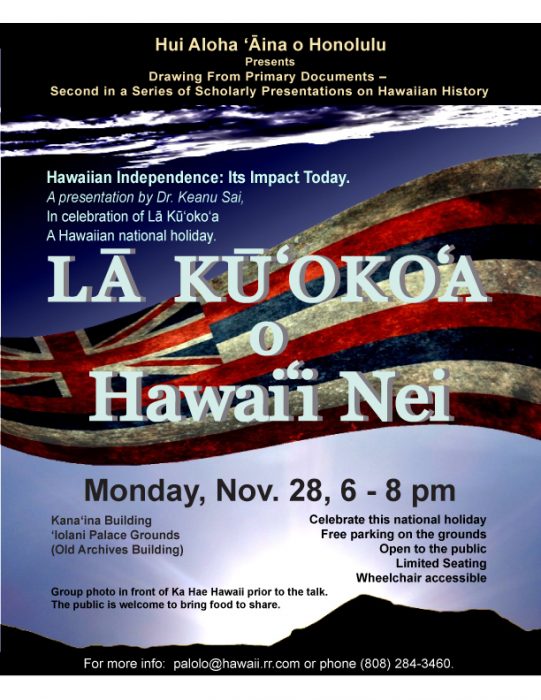


https://vimeo.com/192878178
Dr. Lynette Cruz, host of “Issues that Matter,” interviews Dr. Keanu Sai on recent trip to Italy. Dr. Sai was invited to participate in an academic conference in Ravenna, Italy, as well as guest lectures as the University of Siena Law School and at the University of Torino.

The Smithsonian Asian Pacific American Center (APA) invited Dr. Keanu Sai, along with over forty artists and scholars, to participate in its initiative “A Cultural Lab on Imagined Futures.” APA’s initiative is a unique way to experience a museum. As an agency of the Smithsonian Institute, APA is “a migratory museum that brings Asian Pacific American history, art and culture to you through innovative museum experiences online and throughout the United States.” The traveling museums are called “Culture Labs.”
Imagined Futures will be held on Veterans Day weekend (November 12-13, 2016) at 477 Broadway, SOHO/Chinatown, New York City, from 11 am – 9 pm.
 Dr. Sai’s exhibit is the American occupation of Hawai‘i seen through the lens of the science fiction movie “The Matrix.” The science fiction thriller “depicts a dystopian future in which reality as perceived by most humans is actually a simulated reality called ‘the Matrix,’ created by sentient machines to subdue the human population, while their bodies’ heat and electrical activity are used as an energy source. Computer programmer ‘Neo’ learns this truth and is drawn into a rebellion against the machines, which involves other people who have been freed from the ‘dream world.’”
Dr. Sai’s exhibit is the American occupation of Hawai‘i seen through the lens of the science fiction movie “The Matrix.” The science fiction thriller “depicts a dystopian future in which reality as perceived by most humans is actually a simulated reality called ‘the Matrix,’ created by sentient machines to subdue the human population, while their bodies’ heat and electrical activity are used as an energy source. Computer programmer ‘Neo’ learns this truth and is drawn into a rebellion against the machines, which involves other people who have been freed from the ‘dream world.’”
The Matrix stars Keanu Reeves, as Neo, and the only way he could see the Matrix is to be unplugged by digesting a “red pill” offered to him by Morpheus, played by Lawrence Fishburne.
 Dr. Sai is a political scientist whose academic research has exposed the American occupation of the Hawaiian Islands that began with the United States’ unlawful overthrow of the Hawaiian government in 1893 followed by the military occupation during the Spanish-American War. The American occupation is a subject taught in classes at the high schools and collegiate levels in Hawai‘i and abroad. He is the author of Ua Mau Ke Ea (Sovereignty Endures), a history book used in classroom instruction.
Dr. Sai is a political scientist whose academic research has exposed the American occupation of the Hawaiian Islands that began with the United States’ unlawful overthrow of the Hawaiian government in 1893 followed by the military occupation during the Spanish-American War. The American occupation is a subject taught in classes at the high schools and collegiate levels in Hawai‘i and abroad. He is the author of Ua Mau Ke Ea (Sovereignty Endures), a history book used in classroom instruction.
Dr. Sai also represented the Hawaiian Kingdom as lead Agent in international arbitration proceedings—Lance Paul Larsen v. Hawaiian Kingdom, held at the Permanent Court of Arbitration. The Larsen case was also cited by the Arbitral Tribunal in its judgment in the land mark South China Sea case, which was also held at the Permanent Court of Arbitration. Dr. Sai has been likened to the character Neo.
The Matrix star Keanu Reeves is a cousin of Dr. Sai. Keanu Reeves’ father and Dr. Sai’s mother are first cousins and both were named after Dr. Sai’s maternal grandfather, Henry Keanu Reeves. Both men are Hawaiian.
Dr. Sai’s Exhibit “Hawaiʻi Reloaded – The Matrix Alive!!”
What if the place you lived in and all that you knew to be “truth” was suddenly turned upside down and inside out? What if your understanding of who you are and your place in the world was flipped in an instance? What if you were living a lie and everyone you know were all a part of the lie unknowingly? All this sounds like the Warner Bros. Hollywood blockbuster film the “Matrix.”
Hawai‘i’s political and social history since 1893 is the “Matrix” and it’s called the 50th State of the United States of America. In the nineteenth century, Hawai‘i was known as the Hawaiian Kingdom that was internationally recognized as an independent country with over ninety embassies and consulates throughout the world, which included an embassy in Washington, D.C. The “truth” is Hawai‘i was never a part of the United States, but rather has been under an illegal and prolonged occupation since the Spanish-American War in 1898.
Listen and experience the real history of Hawai‘i through the lens of the Matrix, and what is Hawai‘i’s future going forward.
What is truth, what is justice, what is reality? It’s time to get unplugged!
Today is July 31st which is a national holiday in the Hawaiian Kingdom called “Restoration day,” and it is directly linked to another holiday observed on November 28th called “Independence day.” Here is a brief history of these two celebrated holidays.
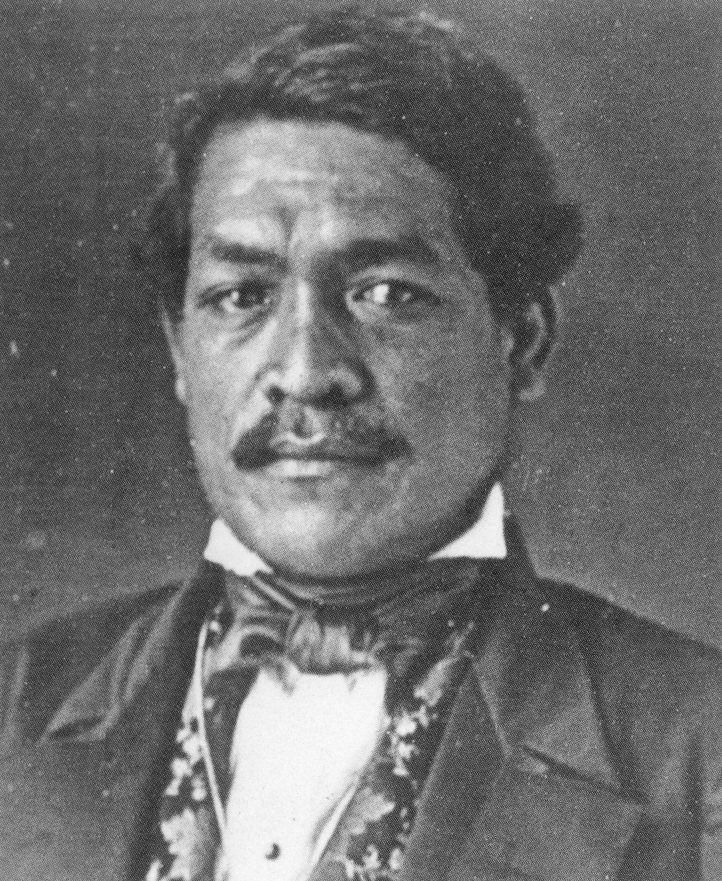 In the summer of 1842, Kamehameha III moved forward to secure the position of the Hawaiian Kingdom as a recognized independent state under international law. He sought the formal recognition of Hawaiian independence from the three naval powers of the world at the time—Great Britain, France, and the United States. To accomplish this, Kamehameha III commissioned three envoys, Timoteo Ha‘alilio, William Richards, who at the time was still an American Citizen, and Sir George Simpson, a British subject. Of all three powers, it was the British that had a legal claim over the Hawaiian Islands through cession by Kamehameha I, but for political reasons the British could not openly exert its claim over the other two naval powers. Due to the islands prime economic and strategic location in the middle of the north Pacific, the political interest of all three powers was to ensure that none would have a greater interest than the other. This caused Kamehameha III “considerable embarrassment in managing his foreign relations, and…awakened the very strong desire that his Kingdom shall be formally acknowledged by the civilized nations of the world as a sovereign and independent State.”
In the summer of 1842, Kamehameha III moved forward to secure the position of the Hawaiian Kingdom as a recognized independent state under international law. He sought the formal recognition of Hawaiian independence from the three naval powers of the world at the time—Great Britain, France, and the United States. To accomplish this, Kamehameha III commissioned three envoys, Timoteo Ha‘alilio, William Richards, who at the time was still an American Citizen, and Sir George Simpson, a British subject. Of all three powers, it was the British that had a legal claim over the Hawaiian Islands through cession by Kamehameha I, but for political reasons the British could not openly exert its claim over the other two naval powers. Due to the islands prime economic and strategic location in the middle of the north Pacific, the political interest of all three powers was to ensure that none would have a greater interest than the other. This caused Kamehameha III “considerable embarrassment in managing his foreign relations, and…awakened the very strong desire that his Kingdom shall be formally acknowledged by the civilized nations of the world as a sovereign and independent State.”
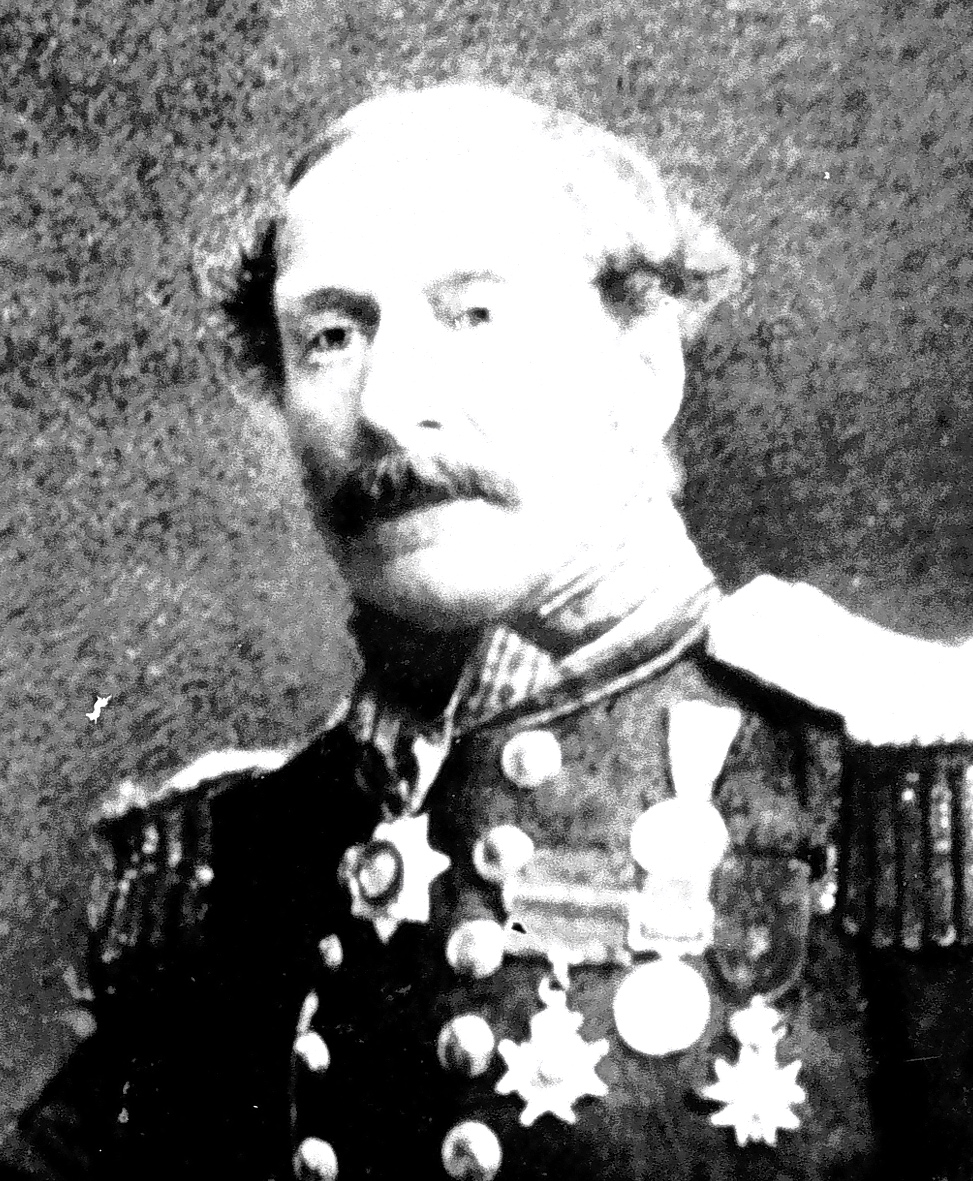 While the envoys were on their diplomatic mission, a British Naval ship, HBMS Carysfort, under the command of Lord Paulet, entered Honolulu harbor on February 10, 1843, making outrageous demands on the Hawaiian government. Basing his actions on complaints made to him in letters from the British Consul, Richard Charlton, who was absent from the kingdom at the time, Paulet eventually seized control of the Hawaiian government on February 25, 1843, after threatening to level Honolulu with cannon fire. Kamehameha III was forced to surrender the kingdom, but did so under written protest and pending the outcome of the mission of his diplomats in Europe. News
While the envoys were on their diplomatic mission, a British Naval ship, HBMS Carysfort, under the command of Lord Paulet, entered Honolulu harbor on February 10, 1843, making outrageous demands on the Hawaiian government. Basing his actions on complaints made to him in letters from the British Consul, Richard Charlton, who was absent from the kingdom at the time, Paulet eventually seized control of the Hawaiian government on February 25, 1843, after threatening to level Honolulu with cannon fire. Kamehameha III was forced to surrender the kingdom, but did so under written protest and pending the outcome of the mission of his diplomats in Europe. News 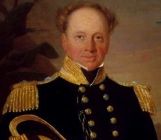 of Paulet’s action reached Admiral Richard Thomas of the British Admiralty, and he sailed from the Chilean port of Valparaiso and arrived in the islands on July 25, 1843. After a meeting with Kamehameha III, Admiral Thomas determined that Charlton’s complaints did not warrant a British takeover and ordered the restoration of the Hawaiian government, which took place in a grand ceremony on July 31, 1843. At a thanksgiving service after the ceremony, Kamehameha III proclaimed before a large crowd, ua mau ke ea o ka ‘aina i ka pono (the life of the land is perpetuated in righteousness). The King’s statement became the national motto.
of Paulet’s action reached Admiral Richard Thomas of the British Admiralty, and he sailed from the Chilean port of Valparaiso and arrived in the islands on July 25, 1843. After a meeting with Kamehameha III, Admiral Thomas determined that Charlton’s complaints did not warrant a British takeover and ordered the restoration of the Hawaiian government, which took place in a grand ceremony on July 31, 1843. At a thanksgiving service after the ceremony, Kamehameha III proclaimed before a large crowd, ua mau ke ea o ka ‘aina i ka pono (the life of the land is perpetuated in righteousness). The King’s statement became the national motto.
The envoys eventually succeeded in getting formal international recognition of the Hawaiian Islands “as a sovereign and independent State.” Great Britain and France formally recognized Hawaiian sovereignty on November 28, 1843 by joint proclamation at the Court of London, and the United States followed on July 6, 1844 by a letter of Secretary of State John C. Calhoun. The Hawaiian Islands became the first Polynesian nation to be recognized as an independent and sovereign State.
The ceremony that took place on July 31 occurred at a place we know today as “Thomas Square” park, which honors Admiral Thomas, and the roads that run along Thomas Square today are “Beretania,” which is Hawaiian for “Britain,” and “Victoria,” in honor of Queen Victoria who was the reigning British Monarch at the time the restoration of the government and recognition of Hawaiian independence took place.
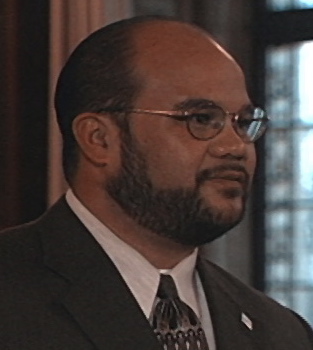 My name is Dr. David Keanu Sai and from 1999-2001, I served as Agent for the Hawaiian Kingdom in international arbitration proceedings under the auspices of the Permanent Court of Arbitration, The Hague, Netherlands. The case was Lance Paul Larsen v. Hawaiian Kingdom (Larsen case). I was responsible for the drafting of the pleadings as well as communication with the Permanent Court of Arbitration’s (PCA) International Bureau-Secretariat, headed by a Secretary General, regarding the case. So I am very well acquainted with the case as well as what was going on behind the formalities of the case and the confines of the published Award in the International Law Reports, vol. 119, p. 566.
My name is Dr. David Keanu Sai and from 1999-2001, I served as Agent for the Hawaiian Kingdom in international arbitration proceedings under the auspices of the Permanent Court of Arbitration, The Hague, Netherlands. The case was Lance Paul Larsen v. Hawaiian Kingdom (Larsen case). I was responsible for the drafting of the pleadings as well as communication with the Permanent Court of Arbitration’s (PCA) International Bureau-Secretariat, headed by a Secretary General, regarding the case. So I am very well acquainted with the case as well as what was going on behind the formalities of the case and the confines of the published Award in the International Law Reports, vol. 119, p. 566.
I am also a lecturer at the University of Hawai‘i with a M.A. and a Ph.D. in political science specializing in international relations and public law. My doctoral research and published law articles centers on the continuity of the Hawaiian Kingdom as an independent State under a prolonged occupation by the United States of America (United States) since the Spanish-American War.
After reviewing the two Awards by the Tribunal in the South China Sea case, I perused the Philippines’ Memorial and transcripts of the proceedings to find any reference to the Larsen case that was cited in Tribunal’s Award on Jurisdiction and Admissibility (paragraph 181) as well as the Award on the Merits (paragraph 157, footnote 98). In the Memorial, which is called a pleading in international proceedings, the Philippines brought up the Larsen case in paragraphs 5.125 and 5.126. It was also mentioned by Professor Philippe Sands, QC, in his expert testimony to the Tribunal during a hearing on jurisdiction on July 8, 2015, and found on page 123 of the transcripts. On the Larsen case, the Philippine Memorial stated:
5.125 The Monetary Gold principle has also been followed once in arbitral proceedings. An arbitral tribunal applied it propio motu in Larsen v. the Hawaiian Kingdom. In that case, a resident of Hawaii sought redress from “the Hawaiian Kingdom” for its failure to protect him from the United States and the State of Hawaii. The parties, who had agreed to submit their dispute to arbitration by the PCA, hoped that the tribunal would address the question of the international legal status of Hawaii. Both parties initially argued that the Monetary Gold principle should be confined to ICJ proceedings. The tribunal rejected that argument, stating that international arbitral tribunals “operate[ ]within the general confines of public international law and, like the International Court, cannot exercise jurisdiction over a State which is not a party to its proceedings”.
5.126 The tribunal ultimately decided that it was precluded from addressing the merits because the United States, which was absent, was an indispensable party. Relying on Monetary Gold, the tribunal explained that the legal interests of the United States would form “the very subject-matter” of a decision on the merits because it could not rule on the lawfulness of the conduct of the respondent, the Kingdom of Hawaii, without necessarily evaluating the lawfulness of the conduct of the United States. It emphasized that “[t]he principle of consent in international law would be violated if this Tribunal were to make a decision at the core of which was a determination of the legality or illegality of the conduct of a non-party”.
There is much said in these two paragraphs that may escape the layman who may not be familiar with Hawai‘i’s legal history and its place in international law. By the Philippines own admission it recognized the existence of the Hawaiian Kingdom as a party to the arbitration, and without the participation of the United States, as an indispensable third party, the Philippines stated the Larsen Tribunal “could not rule on the lawfulness of the conduct of the respondent, the Kingdom of Hawaii.”
Here at the University of Hawai‘i William S. Richardson School of Law, a few faculty members, namely Dr. Diane Desierto, Dr. David Cohen, and Carol Peterson, have gone so far as to call the Larsen case mere puffery. But can the Larsen case be an exaggeration of the Hawaiian Kingdom’s continued existence under international law and the role of the principle of indispensable third parties when it comes to the United States, as claimed by these faculty members who admitted, at a closed forum, they don’t know the legal history of Hawai‘i?
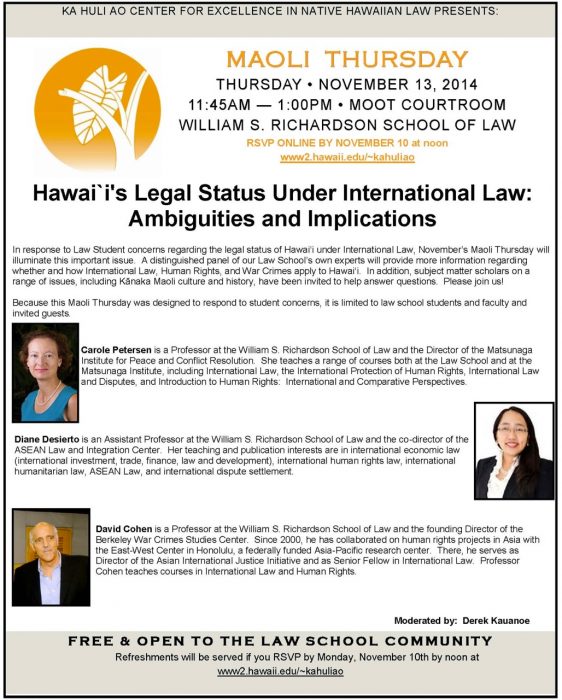
Obviously, the Philippine Government did not think so, and nor did the Tribunal in the South China Sea arbitration. As a landmark case in international arbitration, the South China Sea arbitration has drawn attention to the Larsen case again, which gives me an opportunity to set the record straight in light of the detractors, but also for those who are just curious.
In the Larsen case, the Hawaiian Kingdom, which I served as Agent along with others on my legal team, was a “Defendant,” which in international proceedings is also called a “Respondent.” This means that the Hawaiian Kingdom was defending itself from the allegations made by Larsen, as the “Plaintiff,” which is also called a “Claimant,” that the Council of Regency was allowing the unlawful imposition of American municipal laws in the territory of the Hawaiian Kingdom, which led to his unfair trial and subsequent incarceration.
By going to Larsen v. Hawaiian Kingdom at the PCA’s case repository, it identifies me as the Agent for the Hawaiian Kingdom, identifies the Hawaiian Kingdom as a “State,” and under the heading of “case description,” it provides the dispute as follows:
“Dispute between Lance Paul Larsen (Claimant) and The Hawaiian Kingdom (Respondent) whereby
The Philippines’ Memorial also cites an article by Bederman and Hilbert on the Larsen case that was originally published in the American Journal of International (vol. 95, p. 928), and republished the article in the Hawaiian Journal of Law and Politics (vol. 1, p. 82) that the Philippines cited. According to Bederman and Hilbert, who succinctly stated the dispute, “At the center of the PCA proceeding was…that the Hawaiian Kingdom continues to exist and that the Hawaiian Council of Regency (representing the Hawaiian Kingdom) is legally responsible under international law for the protection of Hawaiian subjects, including the claimant. In other words, the Hawaiian Kingdom was legally obligated to protect Larsen from the United States’ ‘unlawful imposition [over him] of [its] municipal laws’ through its political subdivision, the State of Hawaii. As a result of this responsibility, Larsen submitted, the Hawaiian Council of Regency should be liable for any international law violations that the United States committed against him.”
Clearly, the Larsen case was not about whether the Hawaiian Kingdom continues to exist, but was based on the presumption that it does exist, and, as such, a dispute arose between a Hawaiian national and the Hawaiian Government that stemmed from an illegal and prolonged occupation by the United States. My responsibility, as the Agent, was to defend the Hawaiian Government from Larsen’s allegation of allowing the imposition of American municipal laws in the Hawaiian Islands.
I was also keenly aware that before the PCA could establish the Arbitral Tribunal to preside over the dispute between Larsen and the Hawaiian Kingdom, it had to first confirm that the Hawaiian Kingdom as a “State” continues to exist in order for the PCA to exercise its “institutional jurisdiction” (United Nations Dispute Settlement, Permanent Court of Arbitration, p. 15) so that it could facilitate the creation of an ad hoc tribunal. By extension, the PCA also had to confirm that Larsen’s nationality was a Hawaiian subject, and the Council of Regency was the Hawaiian Government.
As an intergovernmental organization established under the 1899 Hague Convention, I, and the 1907 Hague Convention, I, the PCA facilitates the creation of ad hoc arbitral tribunals to settle disputes between two or more States, i.e., the Philippines v. China, or between a State and a private entity, i.e., Romak, S.A. v. Uzbekistan. Romak, S.A. is a Swiss company that specializes in the sale of grain and cereal products. In both cases, the States have to exist in fact and not in theory in order for the PCA to have institutional jurisdiction. Disputes must be “international” and not “municipal,” which are disputes that go before national courts of States and not international courts or tribunals.
Since the arbitration agreement between Larsen and the Hawaiian Government was submitted to the PCA on November 8, 1999, the PCA was doing their due diligence as to whether the Hawaiian Kingdom currently exists as a State under international law. If the Hawaiian Kingdom does not exist then this fact would negate the existence of the nationality of Larsen as a Hawaiian subject and the existence of the Council of Regency as the Hawaiian government, and, therefore, the dispute.
After its due diligence, however, the PCA could not deny that the Hawaiian Kingdom did exist as an independent State, and, along with other treaties, the Hawaiian Kingdom had a treaty with the Netherlands, which houses the PCA itself. However, what faced the PCA is that it could not find any evidence that the Hawaiian Kingdom had ceased to exist under international law. Only by way of a “treaty of cession,” whereby the Hawaiian Kingdom agreed to merge itself into the territory of the United States, could the Hawaiian Kingdom have been extinguished under international law.
There was never a treaty, except for American municipal laws, enacted by the United States Congress, that treat Hawai‘i as if it were annexed. Municipal laws are not international laws, as between States, but are laws that are limited in scope and authority to the territory of the State that enacted them. In other words, an American municipal law could no more annex the Hawaiian Kingdom, than it could annex the Netherlands.
My legal team and Larsen’s attorney knew this and operated on the “presumption” that the Hawaiian Kingdom continues to exist until evidence shows otherwise. This was the  same conclusion that the PCA came to, which prompted a telephone conversation I had with the PCA’s Secretary General, Tjaco T. van den Hout, in February 2000. In that telephone conversation, he recommended that the Hawaiian Government along with Larsen’s Counsel, Ms. Ninia Parks, provide a formal invitation to the United States Government to join in the arbitration. I recall his specific words to me on this matter. He said that in order to maintain the integrity of this case, he recommended that the Hawaiian Government, with the consent of Larsen’s legal representative, provide a formal invitation to the United States to join in the current arbitration. He then requested that I provide evidence that the invitation was made so that it can be made a part of the record for the case.
same conclusion that the PCA came to, which prompted a telephone conversation I had with the PCA’s Secretary General, Tjaco T. van den Hout, in February 2000. In that telephone conversation, he recommended that the Hawaiian Government along with Larsen’s Counsel, Ms. Ninia Parks, provide a formal invitation to the United States Government to join in the arbitration. I recall his specific words to me on this matter. He said that in order to maintain the integrity of this case, he recommended that the Hawaiian Government, with the consent of Larsen’s legal representative, provide a formal invitation to the United States to join in the current arbitration. He then requested that I provide evidence that the invitation was made so that it can be made a part of the record for the case.
This invitation would elicit one of the three possible responses: first, the United States accepts the invitation, which recognizes the existence of the Hawaiian Kingdom and its government and will have to answer to its unlawful imposition of American municipal laws that led to Larsen’s unfair trial and incarceration; second, the United States denies the existence of the Hawaiian Kingdom because Hawai‘i is the so-called 50th State of the Federal Union and demands that the PCA cease and desist in entertaining the dispute; or, third, the United States denies the invitation to join in the arbitration but does not deny the existence of the Hawaiian Kingdom and the dispute between a Hawaiian national and the government representing the Hawaiian Kingdom.
On March 3, 2000, a conference call meeting was held with John Crook from the United States State Department in Washington, D.C., together with myself representing the Hawaiian Government and Ms. Parks representing Larsen. After the meeting, I drafted a letter to Crook that covered what was discussed in the meeting regarding the invitation and a carbon copy was sent to Secretary General van den Hout, as he requested, so that it could be placed on the record that an invitation was made. A few days later the United States Embassy in The Hague notified the PCA that they denied the invitation to join in the  arbitration, but requested permission from the Hawaiian Government and Ms. Parks, on behalf of Larsen, to have access to all pleadings and transcripts of the case. Both Ms. Parks and I were individually contacted by telephone from the PCA’s Deputy Secretary General, Phyllis Hamilton, of the request made by the US Embassy, which we both consented to. It was also agreed that the records of the proceedings would be open to the public.
arbitration, but requested permission from the Hawaiian Government and Ms. Parks, on behalf of Larsen, to have access to all pleadings and transcripts of the case. Both Ms. Parks and I were individually contacted by telephone from the PCA’s Deputy Secretary General, Phyllis Hamilton, of the request made by the US Embassy, which we both consented to. It was also agreed that the records of the proceedings would be open to the public.
The United States took the third option and did not deny the existence of the Hawaiian Kingdom. Thereafter, the PCA began to form the Arbitral Tribunal the following month in April of 2000. Memorials were filed with the Tribunal by Larsen on May 22, 2000, and the Hawaiian Government on May 25, 2000. The Hawaiian Government then filed its Counter-Memorial on June 22, 2000, and Larsen its Counter-Memorial on June 23, 2000.
After the pleadings were submitted, the Tribunal issued Procedural Order no. 3 on July 17, 2000. In the Procedural Order, the Tribunal articulated the dispute from the pleadings in the following statement.
The Tribunal further stated in the Procedural Order that it “is concerned whether the first issue does in fact raise a dispute between the parties, or, rather, a dispute between each of the parties and the United States over the treatment of the plaintiff by the United States. If it is the latter, that would appear to be a dispute which the Tribunal cannot determine, inter alia because the United States is not a party to the agreement to arbitrate.” The Tribunal, therefore, stated that it could not get to the merits of the case regarding “redress against the Respondent Government” as the second issue, until it address the first issue that Larsen’s “rights as a Hawaiian subject are being violated…by the United States of America.” This first issue that the Tribunal was asked to determine is what caused the Tribunal to raise the principle of an “indispensable third party” that stemmed from the Monetary Gold case. In other words, could the Tribunal proceed to rule on the lawfulness of the conduct of the Hawaiian Government when its judgment would imply an evaluation of the lawfulness of the conduct of the United States, which is not a party to the case.
The Tribunal scheduled oral hearings to be held at the PCA on December 7, 8 and 11, 2000.
https://vimeo.com/17007826
A day before the oral hearings were to begin on December 7, the three arbitrators met with myself and legal team and Ms. Parks in the PCA to go over the schedule and what we can expect. What they also provided to us were booklets of the decisions by the International Court of Justice, namely the Monetary Gold Removed from Rome in 1943 (Italy v. the United Kingdom, France and the United States), Case Concerning Certain Phosphate Land in Nauru (Nauru v. Australia), and Case Concerning East Timor (Portugal v. Australia).
All three cases centered on the indispensable third party principle and that we should be prepared to respond as to how this case can proceed without the participation of the United States. In the Monetary Gold case it was on the non-participation of Albania; the Nauru Case was the non-participation of New Zealand and the United Kingdom; and the East Timor case was the non-participation of Indonesia. Of the three cases, only the Nauru case could proceed because the ICJ concluded that New Zealand and the United Kingdom were not indispensable third parties.
After two days of hearings, it was evident that the Tribunal would not be able to adjudge and declare, according to Procedural Order no. 3, that Larsen’s “rights as a Hawaiian subject are being violated…by the United States of America,” because the United States was not a party to the proceedings. Without a decision by the Tribunal that finds Larsen’s rights are being violated, he would be unable to get to the second issue of having the Tribunal declare and adjudge that he “does have ‘redress against the Respondent Government’ in relation to these violations.” In light of this, I knew that Larsen would not prevail in these proceedings without the participation of the United States. On the final day of the hearings, December 11, I decided to ask the Tribunal to make a determination on a topic that I felt would not violate the indispensable third party principle that was at the center of these proceedings.
The Hawaiian Government needed a pronouncement by the Tribunal as to the legal status of the Hawaiian Kingdom under international law that would deny the lawfulness of American municipal laws within Hawaiian territory. In other words, the Hawaiian Government needed a pronouncement of international law that could be cited as a bar to American municipal laws from being applied in Hawaiian territory. This fundamental bar of one State’s municipal laws to be applied within the territory of another State centers on the legal meaning of “independence.”
In international arbitration between the Netherlands and the United States at the PCA (Island of Palmas case), the arbitrator explained what the term independence means in 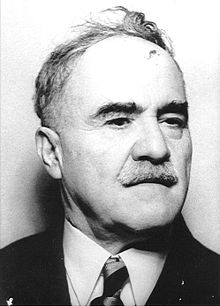 international law. In the Award (p. 8), Judge Max Huber stated, “Sovereignty in the relations between States signifies independence. Independence in regard to a portion of the globe is the right to exercise therein, to the exclusion of any other State, the functions of a State. The development of the national organization of State during the last few centuries and, as a corollary, the development of international law, have established this principle of the exclusive competence of the State in regard to its own territory.”
international law. In the Award (p. 8), Judge Max Huber stated, “Sovereignty in the relations between States signifies independence. Independence in regard to a portion of the globe is the right to exercise therein, to the exclusion of any other State, the functions of a State. The development of the national organization of State during the last few centuries and, as a corollary, the development of international law, have established this principle of the exclusive competence of the State in regard to its own territory.”
Oppenheim, International Law, Vol. 1, p. 177-8 (2nd ed. 1912), explains: “Sovereignty as supreme authority, which is independent of any other earthly authority, may be said to have different aspects. As excluding dependence from any other authority, and in especial from the authority of the another State, sovereignty is independence. It is external independence with regard to the liberty of action outside its borders in the intercourse with other States which a State enjoys. It is internal independence with regard to the liberty of action of a State inside its borders. As comprising the power of a State to exercise supreme authority over all persons and things within its territory, sovereignty is territorial supremacy. As comprising the power of a State to exercise supreme authority over its citizens at home and abroad, sovereignty is personal supremacy. For these reasons a State as an International Person possesses independence and territorial and personal supremacy.”
With this in mind, I made the following statement and request to the Tribunal that is provided in the transcripts of the final day of the hearings on December 11.
The issue before the Tribunal was whether Larsen could hold to account the Hawaiian Government for allowing the unlawful imposition of American municipal laws within Hawaiian territory that led to his unfair trial and subsequent incarceration. My request of the Tribunal on the last day of the oral hearings was to have the Tribunal acknowledge and pronounce the legal status of Hawai‘i under international law as an “independent State,” which, as a co-equal, the United States could not impose its municipal laws within Hawaiian territory without violating international law.
My intent, was to move beyond the dispute with Larsen and address the unlawful imposition of American municipal laws across the entire territory of Hawai‘i and everyone affected by it, not just Larsen. I understood that my request of the Tribunal would not violate the indispensable third party principle, because for the Tribunal to make this pronouncement there would be no need to address the lawfulness or unlawfulness of the conduct of the United States, but merely to acknowledge historical facts.
My request of the Tribunal was similar to the Philippines request of the South China Sea Tribunal to determine whether or not the landmasses in the South China Sea are islands or rocks. The Philippines argued that since it is merely a determination of facts, the Tribunal would not be getting into the lawfulness or unlawfulness of the conduct of States regarding the sovereignty over these islands. The sovereign claims over these land masses would be whether the land masses are islands as defined under the United Nations Convention on the Law of the Sea that establish a maritime zone, or are they rocks that would not establish the maritime zones. According to Article 121(3) of the Convention, an island must “sustain human habitation or economic life of [its] own” in order to generate maritime zones, i.e., the exclusive economic zone (EEZ) of 200 miles from its coast. This is how the Philippines successfully argued why the principle of indispensable third parties would not apply.
On February 5, 2001, the Tribunal issued the Award on Jurisdiction, and concluded that the United States was an indispensable third party. In paragraph 12.5, the Tribunal explained, “It follows that the Tribunal cannot determine whether the [Hawaiian Kingdom] has failed to discharge its obligation towards [Lance Larsen] without ruling on the legality of the acts of the United States of America. Yet that is precisely what the Monetary Gold principle precludes the Tribunal from doing. As the International Court of Justice explained in the East Timor case, ‘the Court could not rule on the lawfulness of the conduct of a State when its judgment would imply an evaluation of the lawfulness of the conduct of another State which is not a party to the case.’”
The Tribunal, however, did answer my request, which is provided in paragraph 7.4 of the Award. The Tribunal stated, “A perusal of the material discloses that in the nineteenth century the Hawaiian Kingdom existed as an independent State recognised as such by the United States of America, the United Kingdom and various other States, including by exchanges of diplomatic or consular representatives and the conclusion of treaties.” By using the phrase, “a perusal of the material,” the Tribunal made it clear that its conclusion that the United States recognized the Hawaiian Kingdom as an independent State was drawn from the facts of the case.
By declaring that the United States recognized “the Hawaiian Kingdom as an independent State,” is another way of stating that the United States recognized that only Hawaiian laws could be applied in Hawaiian territory and not the municipal laws of the United States. Through these international proceedings, the Hawaiian Government was able to broaden the impact of an unlawful occupation beyond the Larsen case to now include all persons that have been victimized by the unlawful imposition of American municipal laws within the territory of the Hawaiian Kingdom.
The Award of the South China Sea arbitration’s reference of the Larsen v. Hawaiian Kingdom is recognition of the integrity of the Larsen case itself and why it is now a precedent case regarding the principle of indispensable third parties along with the Monetary Gold case and the East Timor case. It is also an acknowledgment of the caliber of those individuals who served as arbitrators, two of which are now serving as Judges on the International Court of Justice, namely Judge Christopher Greenwood and Judge James Crawford, who served as President of the Tribunal.
When I entered the University of Hawai‘i Political Science Department to get my M.A. and Ph.D. I also planned to address the misinformation regarding Hawai‘i as the 50th State of the American Union and the categorization of native Hawaiians as indigenous people as defined under United Nations documents. This is a false narrative that has already been rebuked by the mere fact of the Larsen case, which has now become a precedent case in international law. This information about the Hawaiian Kingdom has made people very uncomfortable, but that’s what happens when you’re faced with the truth.